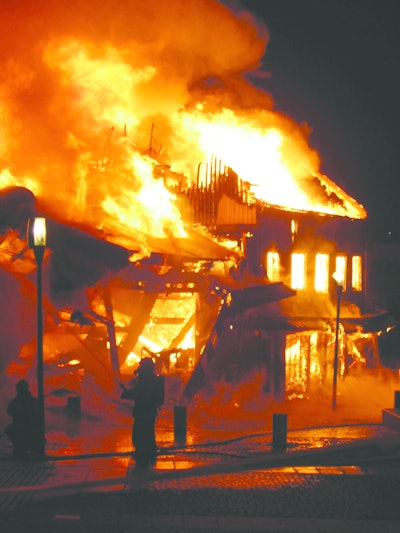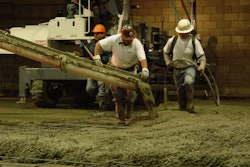
Concrete is the most widely used man-made construction material in the world. It is versatile, economical, durable, recyclable, environmentally responsible and most importantly, it is resilient. Resilience is where the promise of sustainability and the real world meet. And while “resilience” may seem to be just the latest buzzword among green building enthusiasts and building designers, the concept of resilience is something we all need to care about.
It’s not green if it’s not resilient. As society has embraced sustainable design, more and more owners and end users are questioning trade-offs made in the name of being green. This theme was clearly displayed when the cover story of the December 2014 issue of Building Operating Management posed the question: Are Green Buildings Fire Safe? The article pointed out that as the design industry embraced new materials that delivered benefits such as rapidly renewable content, important safety and durability considerations were sometimes ignored. As Louis Gritzo, Vice President of Research for FM Global states: “...a building that burns down is not green, regardless of how it was originally constructed… A green building must be resilient and sustainable in the long-term.” It is this common sense approach that is driving the resilience discussion.
Long term use and serviceability is the key to a building’s sustainability. During the design phase of a contract, if not before, it is important to understand the risk of using inferior materials and how they can compromise safety and the service life of the built environment. Lessons learned on making long-lasting structures may not be in vogue with designers seeking to embrace cutting edge technologies in building materials. However, materials susceptible to fire, attack by insects, and wind or water damage or that are simply not strong enough to endure their surroundings are not sustainable and needlessly put lives and property at risk. A tragic example of this is the balcony collapse in Berkeley, California, on June 16, 2015. The cause of the collapse was directly related to decayed wooden, laminated veneer lumber (LVL) beams. The collapse resulted in 13 college students plunging four floors to the street below. Six of the 13 perished, including five international students. According to the report prepared by the City’s Planning and Development Department’s Building and Safety Division, the balcony failed due to severely dry rotted deck joists that were in service for less than nine years!
The reality is that most of us don’t consider long-term safety when we buy a home or when we go to work, to school, shopping or otherwise go about our daily lives. We assume these structures are safe and resilient. Essentially, we trust that regulatory agencies and government officials charged with protecting our interests have the tools and training needed to limit our exposure to risk. For our trust to be justified, it is critical that building code officials and decision makers really understand the hazards our communities face and what building assemblies and types of construction will protect us from those hazards.
It is time the concrete construction industry works with key allies to educate building code officials and local and state code adoption groups about the advantages and true cost of building with concrete. The more these groups know about concrete, the more they will recognize that concrete is the ideal material to meet sustainable design considerations, for resilience, durability and safety. In addition, we must proactively train designers how to design and build with concrete and concrete products to ensure cost effective, enduring assemblies. The result of these efforts will be safer, more resilient communities that make sustainable use of resources and provide a solid foundation for economic growth and prosperity.
While much of the building industry presumes that concrete is resilient, others may insist we back up this claim. The good news is that time and again, concrete has been recognized by organizations such as the Federal Emergency Management Agency (FEMA), The Federal Alliance for Safe Homes, (FLASH), the National Institute of Building Science (NIBS) and others as the preferred product to withstand the effects of all types of hazards.
Examples of applications where concrete is specified for its non-combustible properties and for its exceptional strength and durability include wildfire safety and tornado protection via safe room construction.1 Likewise, concrete’s robust structural characteristics make it ideal in foundation and wall systems in flood and hurricane prone communities.2 The risk of damage in a hurricane greatly increases as the wind speed and storm intensity; measured by the Saffir-Simpson Hurricane Scale, or storm Category builds. The Florida Homeowners Handbook to Prepare for Natural Hazards,3 states that Category 2 storms are expected to cause structural damage to poorly constructed or termite infested buildings and even well built, small residences may see damage in a Category 3 storm. The Handbook goes onto warn that “extensive damage to non-concrete structures” should be expected for Category 4 storms and “extensive or total destruction of non-concrete structures” will likely occur in a Category 5 storm. Only concrete is resilient enough to withstand Category 4 and 5 hurricanes without significant damage.
As impressive as these applications are, there is perhaps no greater universally applicable reason to build with concrete than fire safety. Regardless of your location, fire safety is an important consideration for residential and commercial construction. According to the latest data from the National Fire Protection Association, firefighters responded to 487,500 structural fires in 2013. Occurring at a rate of about one every minute, these fires resulted in 14,075 civilian fire injuries and 2,855 civilian deaths. On average, fires claim nine lives each day and cause $9.5 billion in property damage. The tragedy of these statistics is that new trends in building codes that allow light frame construction with flammable materials are likely to increase fire related risks.
Since the beginning, building codes in America stressed passive fire safety through non-combustible materials. Since the mid to late 1990s this trend has changed significantly. Stephen Skalko, who is a principal at P.E. & Associates, LLC, explains it this way: “As the building codes transitioned from the three 'legacy codes' to the single International Building Code (IBC) in the late 1990s and early 2000s, the emphasis moved from fire safety in buildings for occupant, property protection and fire fighter safety to mostly occupant safety.” Recent changes to the building code have stressed active fire safety (sprinklers) to provide added time for able bodied persons to evacuate without much regard to the costs due to fire and water damage to the structure. As a result, structures made of lightweight combustible materials are being constructed to greater and greater heights. To put it another way, wood has made a big push in the three to six story commercial structures market where it is displacing concrete as the material of choice.
Each community is exposed to the risks and hazards that are most prevalent in its region. Similarly, all structures, be they homes, office buildings, hospitals or schools, are exposed to some level of hazard risk. By understanding the risk our communities face and offering concrete solutions to mitigate those risks, we help build resilient communities. When we teach designers and agency professionals about the construction practices and materials we deliver, we increase the awareness of our product’s strengths. The economic case is absolutely clear, as the National Institute of Building Sciences’ Multihazard Mitigation Council has demonstrated: investing in resilience pays huge dividends. In disaster prone areas “every dollar spent on mitigation saves four dollars in avoided future losses.”4
In its report, Building Codes: The Foundation for Resilience, FLASH President Leslie Chapman-Henderson and Senior Policy Analyst Audrey Rierson declare that “it’s time to embrace the most essential aspect to resiliency—an uncompromising system of building codes and standards that guarantee a minimum level of home safety, durability and sustainability.”5 It is literally a matter of life and death that we influence how elected officials, policy makers and decision makers view the need for building codes and standards. We must insist that building codes ensure a resilient built environment. As concrete producers and contractors who rely on concrete construction materials, we have a responsibility to inform and educate decision makers that the focus of the current building code system has shifted towards cutting construction costs to the bare minimum and building safety has been neglected.
A key approach to achieving this is to work with industry associations such as the Portland Cement Association (PCA), the National Ready Mixed Concrete Association (NRMCA) and the Concrete Joint Sustainability Initiative (CJSI) as well as organizations such as the Federal Alliance for Safe Homes (FLASH) and the Insurance Institute for Business & Home Safety (IBHS) that help drive building code adoption to provide safer, more secure buildings and infrastructure. As construction/building industry representatives, we should develop relationships with elected officials, state and local agencies to explain why passive fire safety is critical and how our products can save lives when disasters strike. When you network with engineers and the design community to push for sustainable and resilient roads, bridges and buildings made with concrete, you are helping your community make a solid investment.
References:
- Taking Shelter from the Storm Building a Safe Room for Your Home or Small Business FEMA P-320, Fourth Edition / December 2014
- Coastal Construction Manual Principles and Practices of Planning, Siting, Designing, Constructing, and Maintaining Residential Buildings in Coastal Areas (Fourth Edition) FEMA P-55 / Volume II / August 2011
- Gulf of Mexico Alliance – Florida, http://www.gulfofmexicoalliance.org/state-by-state/florida.php, ISBN: 978-0-9850952-2-2
- Security & Disaster Preparedness, Online Reference, June 30, 2015, Available at https://c.ymcdn.com/sites/www.nibs.org/resource/resmgr/Docs/-NIBS_Factsheet_SDP_MMC.pdf
- Leslie Chapman-Henderson, Audrey Rierson, “Building Codes: The Foundation for Resilience”, May 2014, FLASH, Tallahassee, FL


















